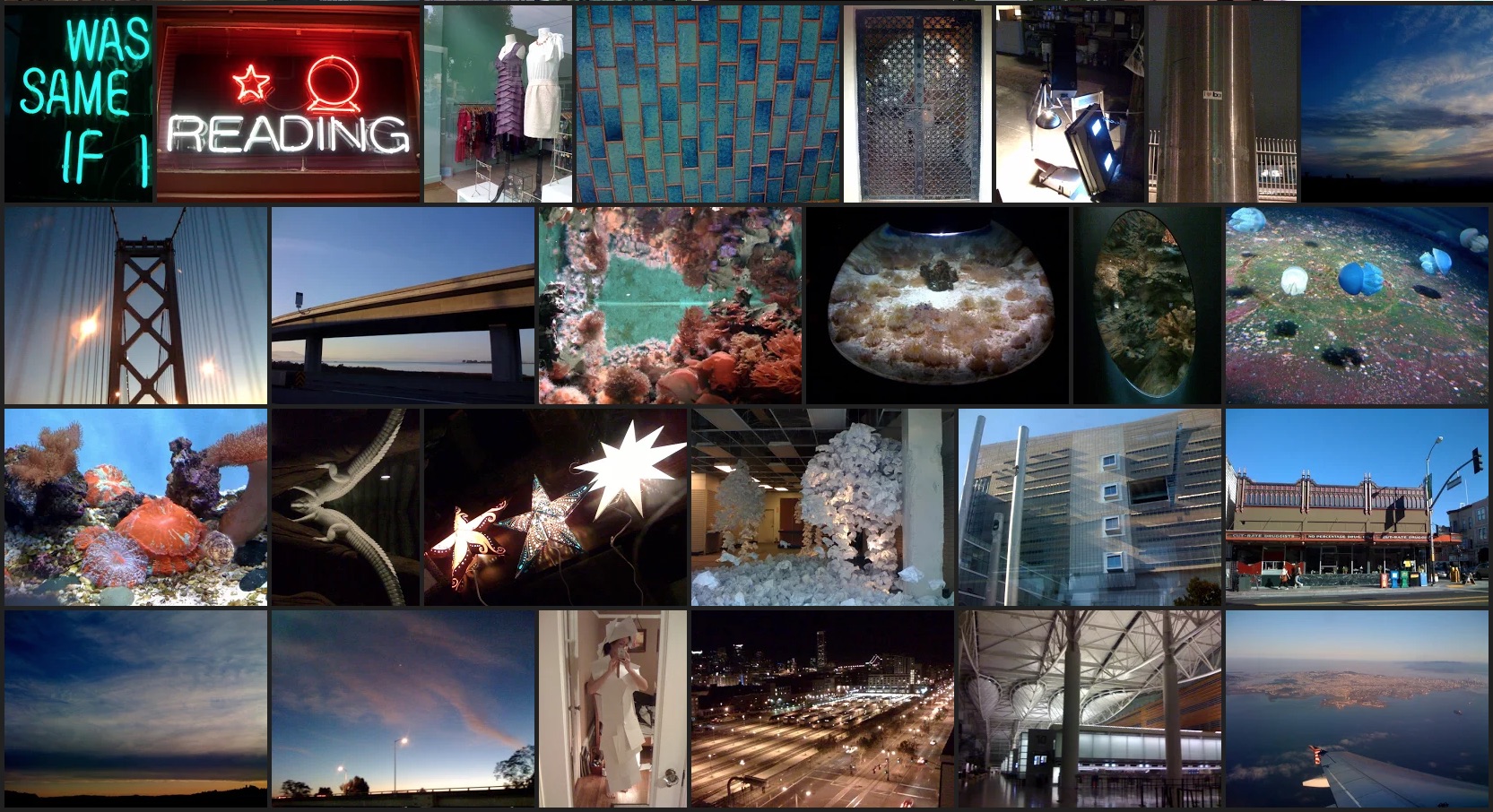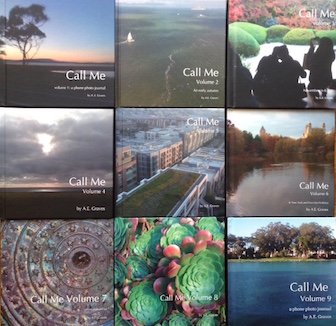

I have loved making photographs since I was in my teens, when I first wrested a lovely 1971 Nikon FTN away from my father for a summer photography course. The camera has a fast lens, and working with it over the years, I came to know its every strength and weakness, which allowed me to successfully take photographs in all kinds of lighting conditions. The heavy camera was a treasure, and I would carry it with me often, mostly on weekends, despite its bulk. I had to limit my use only because of the cost of film and developing, but I budgeted as well as I could for this, and shot regularly.
Every chance I got, I would take photographs. The conventions of the film era dictated that photographs be taken to mark life's major events: the arrival of babies, each of a child's firsts, major school milestones, graduations, relationships, celebrations, major public holidays, vacations, anniversaries, and so on. My passions include landscapes and botany, and I am lucky enough to live in California, which has spectacular scenery, and in San Francisco, which has an exotic Mediterranean climate that allows us to grow plants from southern Europe, South Africa, Australia, and elsewhere! These passions give me subjects that didn't require that I limit my activities to these social conventions. I also trained as an architect and worked in architecture in my youth (prior to developing the hybrid architecture+complex-legal-contract specialty that took my career in another direction), and San Francisco holds some interesting buildings from the Spanish Mission era through contemporary times. Photo album after album filled up with prints from my local lab, documenting these passions in small doses, week after week.
I bought a small, smart film camera, so I could have a camera with me every day. My photographic practice expanded to include a photo diary, since I could take photos from a window in my office building, of a sunset on my bike ride home, of flowers blooming on the way to the train station. The moments that I found beauty in every day could be recorded easily. I could preserve and share those moments. They still fell within my passions, but allowed me to expand my scope without much fuss, to be more opportunistic.
I was prolific during the film era, but this didn't mean that it was easy to show my images to anyone. The Internet in the early 1990s wasn't photo-friendly: you had to download files through slow modems, and then process binary files on your local machine! The technology wasn't "there," so I only shared my photos in person, or by sending prints to my friends through the mail. It wasn't until the advent of the World Wide Web and the low-res digital photography era that my prolific photo frenzies had an Internet-ready outlet. The display and gallery tools were primitive, but gradually, the smart-phone era moved us to a point where having a phone-camera meant that you could take a photo, and share it within MOMENTS, rather than days. Since I already had a nearly-daily photo practice, the idea of putting my photo diary on-line made perfect sense to me.
If you keep a camera (or camera phone, or phone camera, or digital camera, or...) with you at all times, you can record day-in-the-life scenes which defy conventions. Yes, can still record major life milestones, but you can also record a particularly pleasant sunrise while walking to work while knowing that it is unique, and there will never be one exactly like it during your lifetime. You don't have to limit yourself to the drunken selfies and "proof I have friends" conventions!! Those are for the conformists who need to be told what to do, and YOU aren't like that! :)
In my own practice, I am looking for great lighting on my subjects. Lighting is what MAKES a photograph good. My father has often said that you can't take a bad photograph in Yosemite, but I disagree: there are thousands of bad photos of Yosemite! The truly great photos of Yosemite occur when the lighting and weather are perfect, and those are vastly different from their overcast, midday, uninspired, vista-point-parking-lot counterparts. Lighting makes or breaks a photo, and if you have a camera with you, especially during those "Golden Hours" near sunrise and sunset, you can take a technically impressive photo of otherwise uninspired buildings and places, which are great because of how they are lit. The lighting can really change the mood, can call attention to a child running, to a long shadow on an otherwise uninteresting wall... I've been late to work because the lighting on my walk to the train station lit something spectacularly that had never been lit quite that way before. It is worth the stop!
Taking regular photos of my hometown, I wind up documenting changes I hadn't anticipated. I have photographs of murals that no longer exist, buildings that have completely new skins, construction sites which are now luxury hotels, saplings that are now trees, movie theaters that are now gyms... My collection has a documentary aspect that wasn't obvious at the time, but which is clear in retrospect.
My photographs from my hometown and my travels show aspects of places that I wouldn't think to describe when people ask. An odd shop window with giant letters I like. Ridiculous shoes. Concert posters on walls covered with guerrilla art. Rare, cloud-free days over Mount Ranier. Shadows of fire escapes on brick buildings. Hand painted signs for businesses that haven't existed for decades. These kinds of details give places a richness and texture that I enjoy enormously.
Having studied my neighborhood, the surroundings of the places where I have worked, the restaurants where I like to eat, and having visited again and again while waiting for the right light to capture a mood, I feel that I've gotten to know these places better. My relationship with them is more intimate, deeper. I recognize a wall panel on a building I photographed, the light bulbs that hang from the coffee house that roasts some of my favorite coffees, the reflections on the surfaces of the buildings I used to walk past... Much like biking through the City regularly, photographing it has burned details into my memory that I might not have noticed otherwise.
If you have the sort of passions that I do - architecture, landscapes, botany, faceless fashion mannequins, aerial views out of airplane windows - you can easily build massive collections of these images over time. A few images in any given week are no big deal, but cumulatively, I have an impressive collection!
I am a huge advocate of incremental creative progress. Most of the photographers, authors, and other creative people you admire, you are admiring in retrospect. Over the course of their lives, they developed a large body of work. While the media today constantly looks for 'the next big thing,' the established creatives have built a body of work over decades, and can mix and match work from different time periods to make a more cohesive set of writing, images, poems, or paintings on a subject. This isn't always obvious in "fast media," which focuses only on what is new and novel, but it is clearly visible in "slow media," such as retrospective art shows, books, and collections. If you look at keeping a photo journal as an in-the-moment activity, which it is, you should realize that it also is a long term, journalistic practice that can contribute to your lifelong "oeuvre."
Rather than going to Yosemite and expecting to make a perfect set of images during a narrow window of a few days, when you are subject to the vagaries of weather, season, air quality, and mood, you can visit Yosemite again and again during different times of years and REALLY get to know the place. You can document the conditions each time you visit, and try to top the images you have taken previously. The results may be pleasing each time, but those results add up to something bigger as you add to your best-of collection. Your best-of-this-visit choices may change, and be replaced by images which are the best-of-twenty-visits. The more you have, the more best-of options you can make.
 I kept an iPhone1 photo blog at mobilelene.blogspot.com from January 2008 until my phone turned itself off for the last time in September of 2012. I chose to post 2,578 images from my daily life and special trips during that time, though I took thousands more. I was so prolific that I wound up producing a hefty series of books which include every photo I took and saved on my phone, less a few duplicates. Even after nine thick volumes, the book set still remains to be completed. (It takes a long time to lay out books with a thousand images or so each!)
I kept an iPhone1 photo blog at mobilelene.blogspot.com from January 2008 until my phone turned itself off for the last time in September of 2012. I chose to post 2,578 images from my daily life and special trips during that time, though I took thousands more. I was so prolific that I wound up producing a hefty series of books which include every photo I took and saved on my phone, less a few duplicates. Even after nine thick volumes, the book set still remains to be completed. (It takes a long time to lay out books with a thousand images or so each!)
Looking back through the blog and through my books, I can see patterns in my habits and interests that weren't obvious to me at the time, affection for the weather, and my clear enthusiasm for all of my passions. I can see how I revisit subjects until I have a favorite image of them, something that captures the way I want to remember them, and then I stop photographing that subject unless I see some new aspect of it. This means a flurry of photographs when something is "new," and then a gradual decrease as I look at those same topics more thoughtfully.
I've learned from my photo journal habits, and now also have a massive collection of images to draw inspiration from for my other interests, which include painting and drawing.
When my iPhone1 shut off, I decided to make a change in how I share. I am still keeping a photo journal, but now I am keeping a private one, and am publishing album-length selections on my Google+ account. (These will migrate to other platforms once Google+ is turned off in 2019.) I am also waiting to publish rather than doing so immediately, so I can do so with a sense of what is important to me in retrospect, rather than in the moment. This is educational for me in different ways than my immediate posting was.
I highly recommend keeping a photo journal, whether or not you choose to publish it on the web, print the collections as books, or just keep the images in your archive. The long-term perspective a photographic journal provides can give you insights on your work and serve as inspiration for future projects.
images and original text Copyright © 2014 A. E. Graves
(posted December 27, 2014 refreshed January 2019)